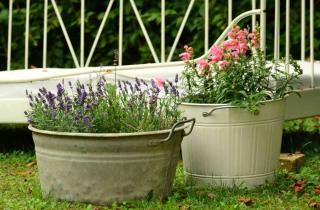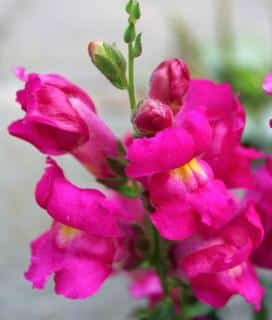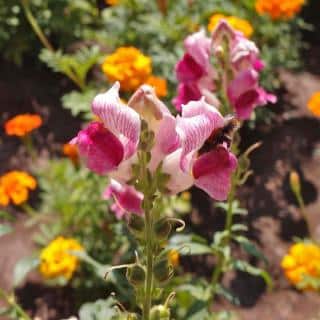

Snapdragon is a superb annual flower that blooms all summer long and even longer, lasting up to fall.
Summary of Snapdragon facts
Name – Antirrhinum majus
Family – Scrophulariaceae
Type – annual
Height – 6 to 48 inches (15 to 120 cm)
Exposure – sun
Soil – rather rich, well drained
Flowering – June to September/October
Snapdragon is a plant that self-sows year after year, and this will explain how to get the cycle launched at the start.
 If you intend to directly purchase your snapdragon in nursery pots, it is best to plant it in spring, towards the month of May, for it to bloom in summer.
If you intend to directly purchase your snapdragon in nursery pots, it is best to plant it in spring, towards the month of May, for it to bloom in summer.
Whether the plant is in a container or in the ground, select a sun-filled spot for maximum blooming.
In pots, simply make sure drainage is very good (holes at the bottom of the pot) for excess water to drain away. Here, pink snapdragon is paired with potted lavender.
 If you’re looking to sow snapdragon seeds, get started at the end of winter and transplant in spring.
If you’re looking to sow snapdragon seeds, get started at the end of winter and transplant in spring.
 Snapdragon is a plant that only calls for very little attention.
Snapdragon is a plant that only calls for very little attention.
Simply leaving your snapdragons be without disturbing them will ensure they re-sow spontaneously year after year.
Even though it is an annual plant, snapdragon can perfectly withstand mild winters and sow seeds again and again.
It can hold to temperatures down to about 23°F (-5°C).
If you live in an area where the winter is very cold, try to protect your snapdragon with a thick cover of dried leaves, hoping to see the seeds sprout in the following spring.
There are several different snapdragon varieties. Some are quite tall and are marvelous in flower bouquets, others are dwarf and semi-dwarf varieties that are perfectly suited to flower beds and to garden boxes and pots.
 The taller varieties are best represented by the ‘Madame Butterfly’ which grows about 40 inches (100 cm), and ‘Grand loup’ or ‘Race precurseur’ which grow even taller.
The taller varieties are best represented by the ‘Madame Butterfly’ which grows about 40 inches (100 cm), and ‘Grand loup’ or ‘Race precurseur’ which grow even taller.
Dwarf and semi dwarf varieties are cute with the ‘Tom Pouce’ at 8 inches (20 cm), ‘Black Prince’ at 16 inches (40 cm), ‘Goupil’ at 20 inches (50 cm) and ‘Race Sonnet’ at 24 inches (60 cm).
Many colors are available. Snapdragon flowers range from pink to yellow and include purple, violet, white and orange.
Your snapdragon may actually change colors in the course of time, this is perfectly normal.
Since these flowers regenerate from seed every year, each generation can vary and have a different appearance.
Snapdragon is also used in cooking where it shines with very interesting culinary properties.
Although the base taste is bitter and sometimes a bit spicy, it is very ornamental. If you like the taste of endive, you’ll find it quite similar.
Flower your garden, balcony or terrace with snapdragon for a landscape that is full of colors!